Here:
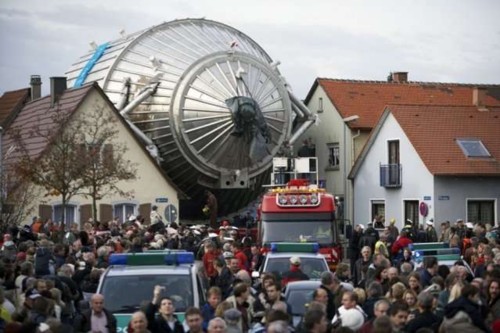
It reminds me of the scene at the end of Starship Troopers (a scene which I may now be imagining (but I think it happened)) where the victorious Starship Troopers celebrate their capture of The Queen Bug.

Here:

It reminds me of the scene at the end of Starship Troopers (a scene which I may now be imagining (but I think it happened)) where the victorious Starship Troopers celebrate their capture of The Queen Bug.
My expedition to check out the Optic Cloak got me appreciating the new version of the Greenwich Peninsula, the post-Dome version, that is now taking shape.
Here is a picture of it, one of those computer fake photo things:
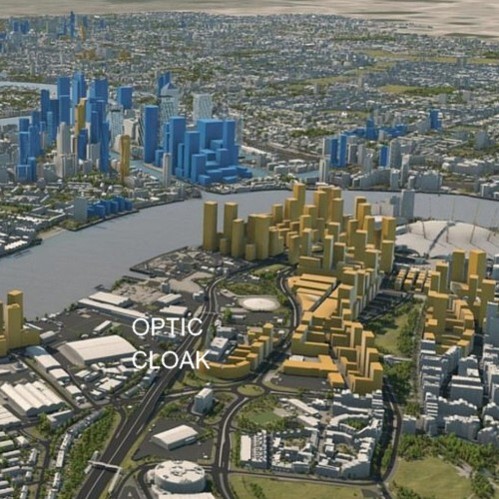
The Optic Cloak is an invisible smudge of grey, just after the C of OPTIC and just above the K of CLOAK. That’s because this picture is not about the truth as such, but about new tall buildings, and the Optic Cloak, although quite tall, is not a building, so, in this picture, it is ignored.
However, what the above photo does show is the big double-barrelled road which takes traffic into and from the Blackwall Tunnel. And you get a great look at this mighty traffic artery if you climb up onto a footbridge that takes you over it. Over it if, for instance, you are walking south from North Greenwich tube station, in order to get a closer-up view, from the West, across the big road, than you’d get otherwise, of the Optic Cloak, as I was when I went there, however many weeks ago it was.
You can just about make out this footbridge in the picture above, just above and to the right of the C of COPTIC.
Here are a couple of photos that I photoed of this footbridge:
And here are a couple of views from it, of the Optic Cloak:
But I especially liked the sort of views you get from this footbridge, looking north, towards the Blackwall Tunnel:
Most of the towers in the distance there are across the river, in Docklands, and already that view, as you approach the Blackwall Tunnel is quite something. As the Greenwich Peninsula itself fills up with more towers, it will look even more mini-Manhattan-ish.
Here are photos I took from the bridge of a couple of interesting vehicles, going north (left) and south (right):
Plus, here is a close-up of that roof clutter, in the left hand of the two looking north photos, above:
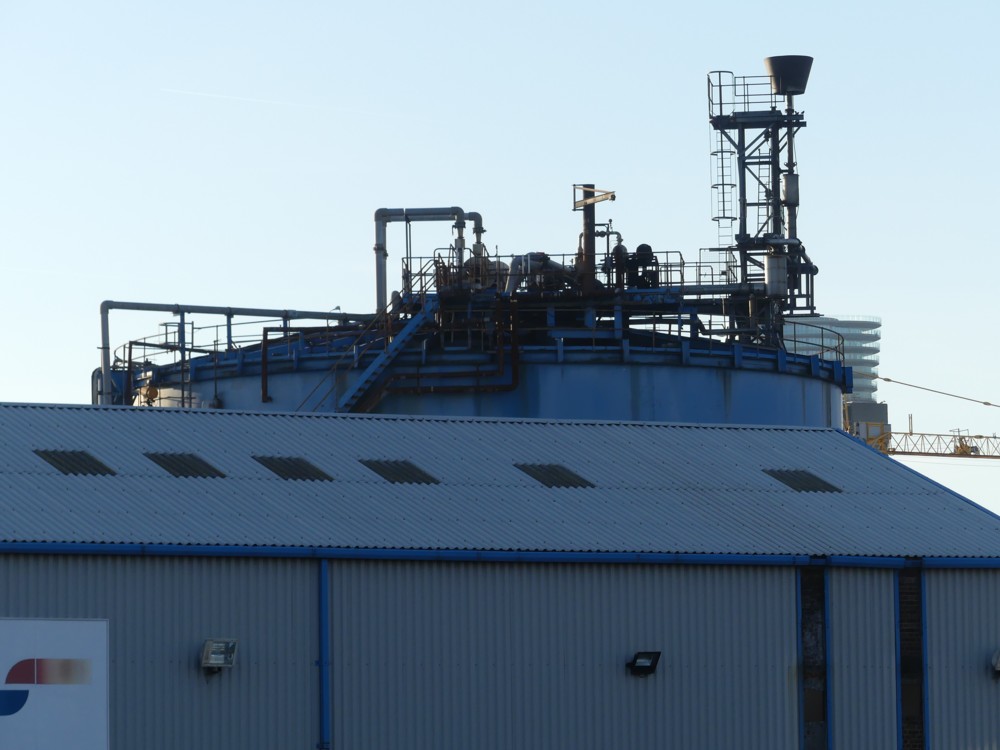
This roof clutter makes a point, as do those two views looking north, and the traffic. This new Greenwich Peninsula has the feeling of old-school work getting done, just as I presume the old one had. Stuff that really hurts if you drop it on your foot is being made, modified, bought and sold, in this particular part of London, just as it always was. Noxious gasses and fluids are being propelled hither and thither, in pipes and cans and lorries. You get the feeling that this isn’t going to stop any time soon, the way it has in Docklands.
It could just be all that Blackwall Tunnel traffic thundering by which gives off that feeling. However, I don’t think so, if only because the thundering traffic creates the sort of place where the Financial Services Industry wouldn’t want to be.
Here, finally, is the kind of close-up of the Optic Cloak that I had come for …:
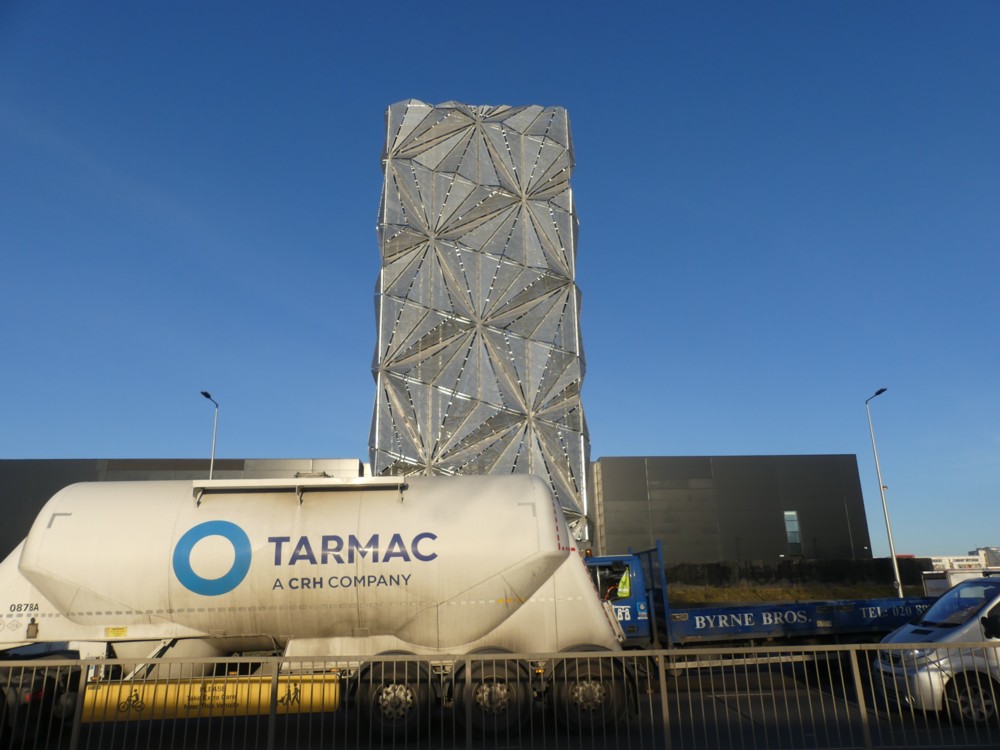
.. with a lorry roaring by, full of noxious fluid.
There can be no higher praise for the Optic Cloak than to say that it fits right in with all this hustle and bustle and noise. Indeed, it dominates it. It presides contentedly over it. Most “Art” in such a place would look ridiculous.
I took this photo of the big 3D map of London that is in the Building Centre, Store Street, in 2010:
And here is a close up of that distant City Cluster that you can vaguely discern in the distance, above:
Gherkin, tick. Cheesegrater, tick. Crossrail, semi-tick, still slogging its way towards belated completion. But, note the Helter Skelter, which never happened. That’s the tall and twisty one in the middle there, that looks like a helter skelter. They started it, but then they (presumably a different they) turned what they had into something different, 22 Bishopsgate.
Some photos get better with the passing of the years. Soon, the Helter Skelter will be largely forgotten.
Outside my front door, a few days ago:
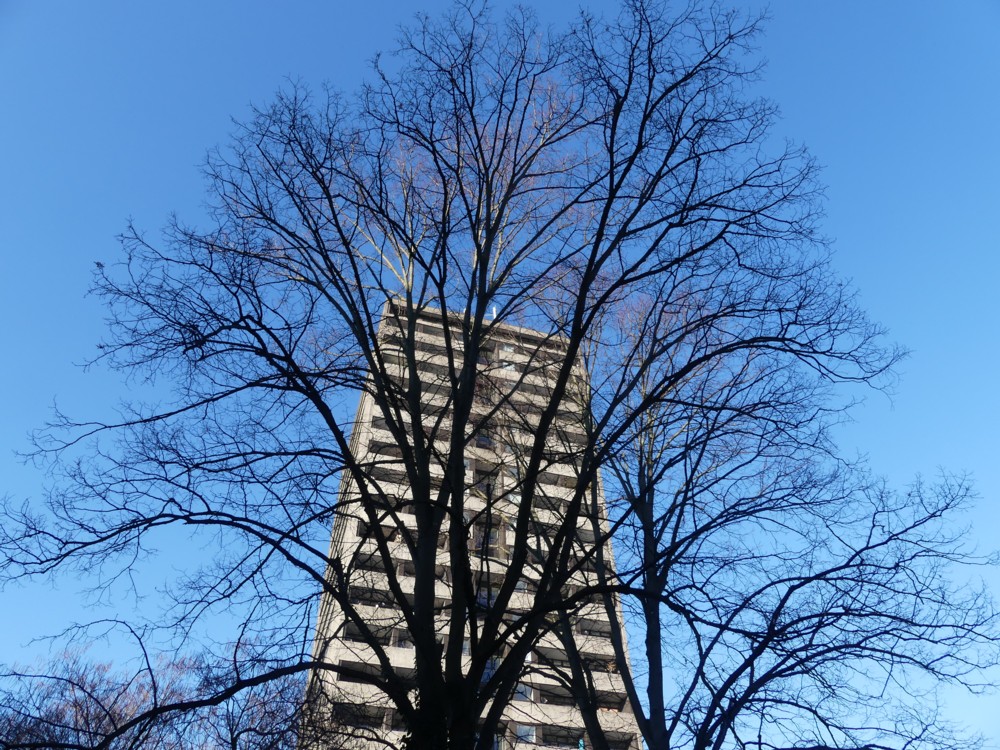
I like how the sun picks out some of the branches at the top, but only some.
More “The February Summer of 2019” photos, of a similar sort, at Mick Hartley‘s.
How to photo the Wheel? Well, here is one way:
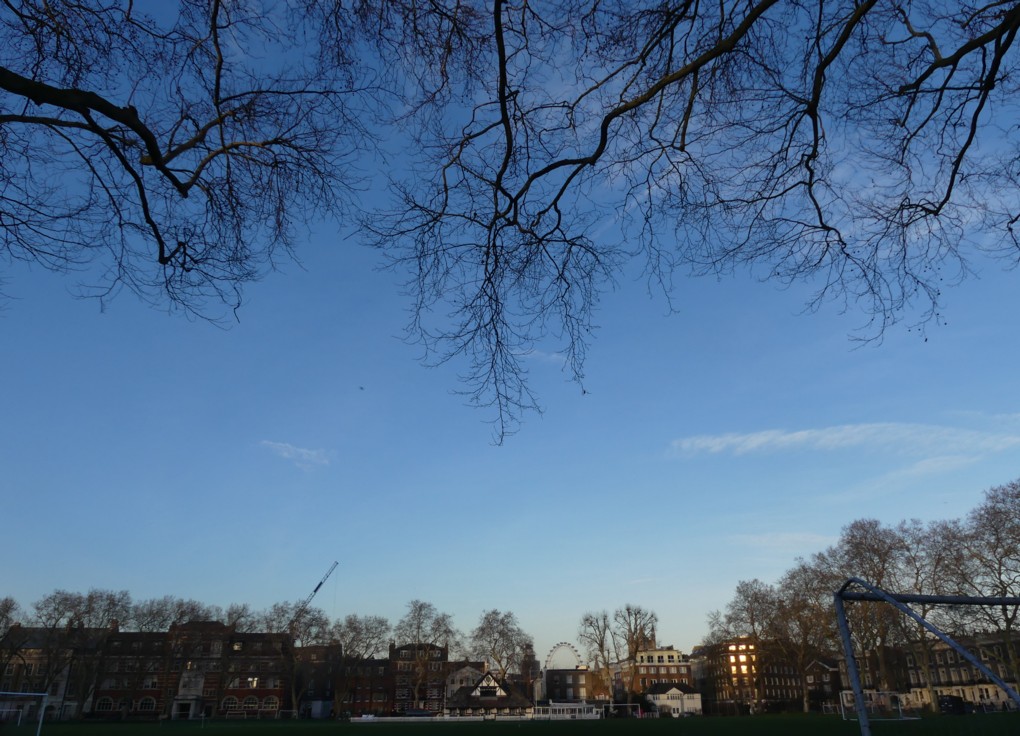
Last Friday, as darkness approached, from Vincent Square.
Well, well. Look what I just found in the photo-archives. I wasn’t looking for this photo. I just found it, while looking for just anything interesting to stick up here, instead of a proper posting, which I don’t have the energy for:
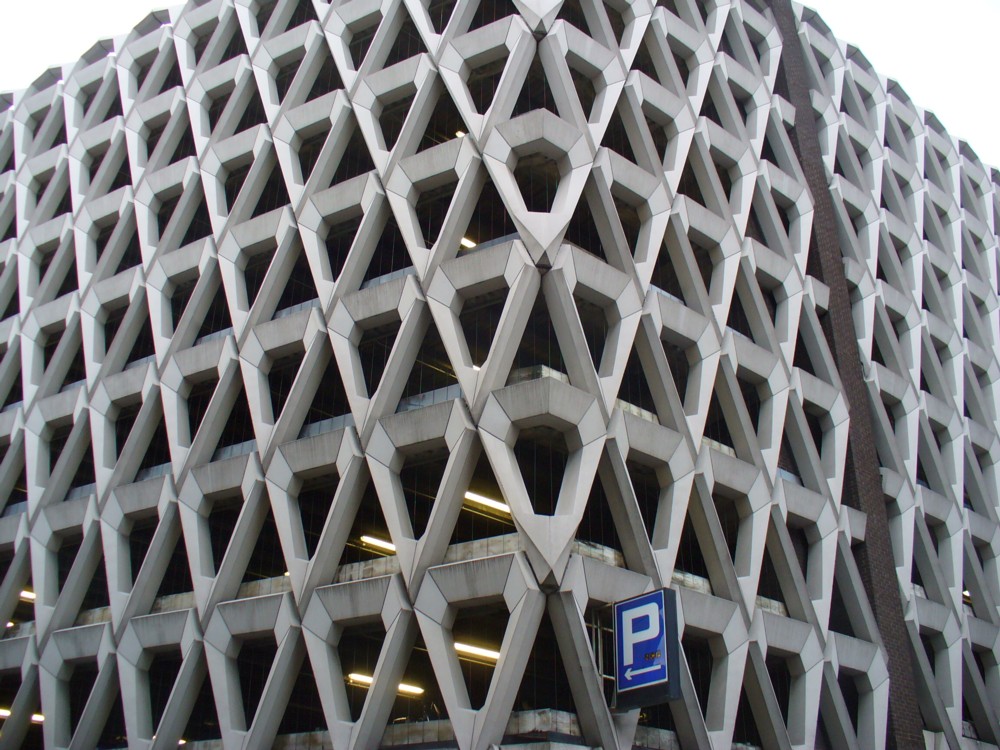
That photo was photoed on April 20th 2006, according to my computer.
The reason I was so pleased to find the above photo is that I was photoing the very same edifice, this very afternoon. This was a resolution I proclaimed to the world in this posting here, a few days ago.
I can now report that the Welbeck Street Car Park is, as of now, still there. There’s no P on it, like there is in the above photo. There are now, I believe, no cars in it. It awaits demolition. But it has yet to be demolished. It is still all there.
Here is the similar photo I took today, that makes it look like the car park that it is:
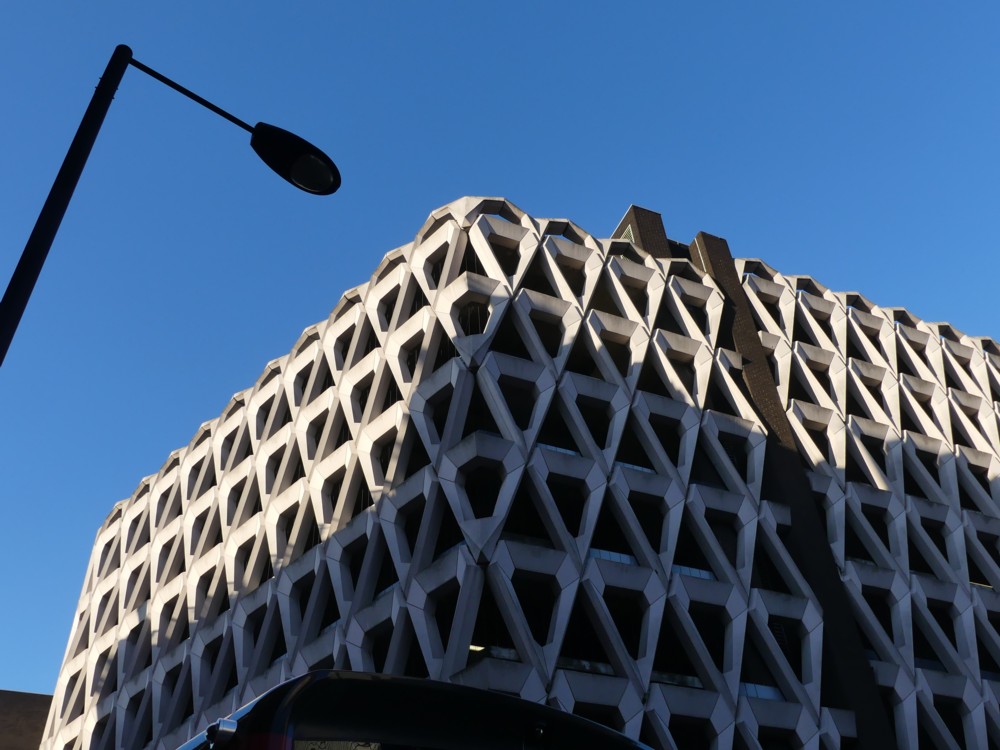
No P. Different light. Otherwise little seems to have changed.
Here is this same car park, bounced off the front of a car.
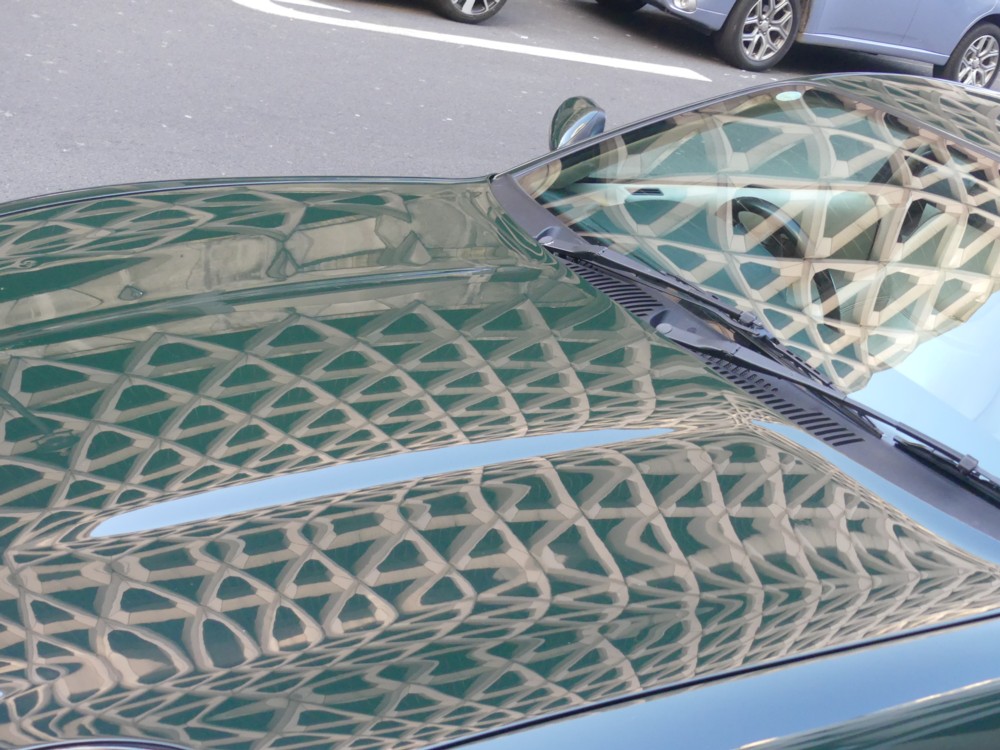
That takes me back. Time was when I was fascinated by what you could see in the shiny bits of cars. But I don’t recall ever doing a car reflection photo as fun as that one. It’s the pattern of the concrete that makes it.
This Welbeck Steet Car Park thing is very interesting I think. I mean, why the fuss about some manky old car park, just because its facade is made of triangular concrete lumps instead of the usual rectangular concrete lumps? I promise nothing, but may even supply the answer to that question, some time.
The Park Tower Knightsbridge Hotel is what Wikipedia calls it. Sheraton now calls it the Sheraton Park Hotel. Whatever we call it, this is one of my favourite London buildings from the concrete monstrosity era, partly because nobody who worries about being aesthetically elevated likes the work of its architect Richard Seifert. Such people also do not like One Kemble Street, or Centre Point, also by Seifert, either. Too commercial. Too brash. Too assertive. Too symmetrical. Starchitecture before Starchitecture became chic, and not chic enough.
All the photos you see on the internet of this Park Hotel tend to look like this …:
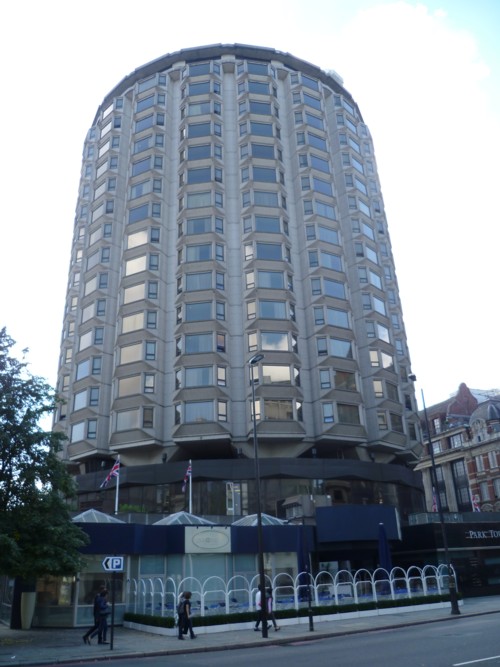
… i.e. photoed from nearby, so that you can’t see the magnificence of the Roof Clutter on the top.
So now I will correct this regrettable imbalance, by inserting these views of the Park Hotel photoed by me last Friday from way off in the middle of Hyde Park, into the vast ocean of internet imagery, in the hope that public attention will be drawn to this wonderful and spontaneous assemblage of roof sculpture:
I especially like that last one. Trees, mist, and then Park Hotel, in soft focus. Or, out of focus, as we digital snappers say.
Norman castles were evil stone monstrosities when first inflicted upon this green and pleasant land. But as that style retreated, they turned into picturesque ruins. The Concrete Monstrosity style is already in headlong retreat, and I like it more and more.
Memo to self: check out this car park, before they destroy it, which they have now decided that they will.
Last Thursday afternoon, I emerged from North Greenwich tube/DLR station, and started getting my bearings. Dome right here, there, so that’s north, so south is the other way, and somewhere around there ought to be the Big Thing itself, called (it has to be called something) The Optic Cloak. (If it has a local nickname, I am unaware of it.) Because it’s a Big Thing vaguely shaped like a domino, and because it takes itself very seriously and because it’s not for people to live it, it reminds me of the Big Thing at the beginning of 2001 A Space Odyssey, despite its ziggy zaggy surface.
And very quickly, after hardly any walking south at all, I got my first sightings of the OC.
Here are nine of the first lot of photos I took of the OC:
All of these photos have something else in them besides the Optic Cloak itself, and this is deliberate.
Real Photographers are very clever at screening out all irrelevancies, when they photo a Thing like this. They go for the special effects that the Thing itself contrives, with no lampposts or surveillance cameras or cars or general crap inserting themselves into the final photo. The results often (a) are very beautiful (provided the Thing itself has something beautiful going for it), but (b) in no way prepare you for how the Thing actually looks, in its actual setting, when you actually get there. Real Photographers, to generalise, are better at lying with their cameras than snappers like me are, which means that snapper-photos are often superior, as actual guides to what Things really look like.
I especially like the trees, through which Things may now, at this time of the year, be seen, unlike in the boring old summer.
And I especially like all that blue sky.
Here. The verdict is: They knew what they were moving into. They should install blinds or net curtains.
Or, turn the viewable-from-the-Tate-Extension living rooms into art installations. The judge didn’t say that; I’m saying that now.
I’m rather surprised by this verdict, but also pleased. Because this is now one of my favourite London photo-spots, and there is lots to be seen looking south, besides into other people’s living rooms.
From this spot I have photoed many, many photos, of which these are just four, taken in July and August of 2016:
Those photos all illustrate the problem that the flat-owners now have.
But, this next little clutch of photos, taken at the same time, illustrate what could be another answer:
In these photos, what dominates is the way that light, rather than coming through the window from those living rooms, is instead coming from outdoors London and bouncing off the windows. At the time I took these photos, I was thinking about that (to me) rather appealing crinkly brick surface that this Tate Modern Extension is covered in.
But now, it seems to me that I was photoing another sort of answer to the problem that these flat-dwellers now have. Could the glass windows be replaced by glass that is more reflective of light, while still letting the outside view in? Or, could the existing windows have some sort of plastic film or sheet stuck on them, preferably on the inside but maybe on the outside, that would contrive the same effect?
A problem stated is often well on the way to being a problem solved. The judge said: It’s up to you to stop the light bouncing off the interior of your home from zooming up to the onlookers at the top of the Tate. You knew this was going to happen. Sort the problem yourselves.
It will be interesting to see how things change with these windows, and inside these living rooms, in the months and years to come.
I left it too late and I am now too tired to do anything here today, so here’s a random quota photo:
Taken in May 2015, from the South Bank, looking north across the River. I’m pretty sure that’s the Royal Opera House Covent Garden. But feel free to disagree.
I hope – although I promise nothing – to do better tomorrow.